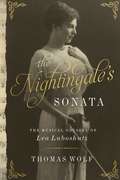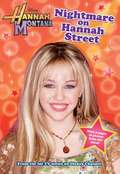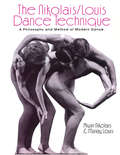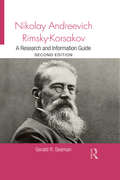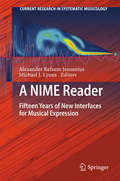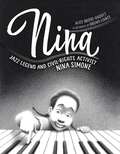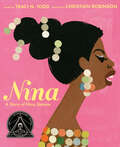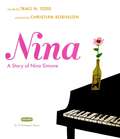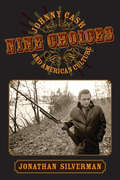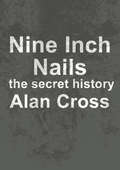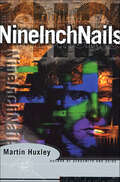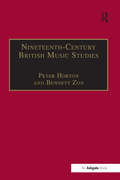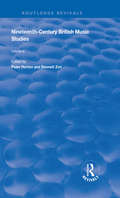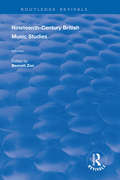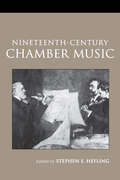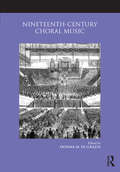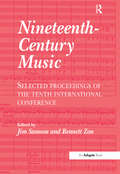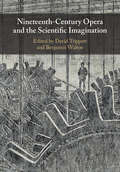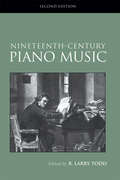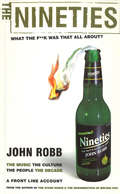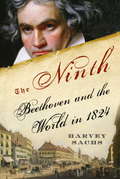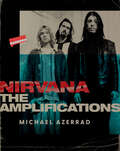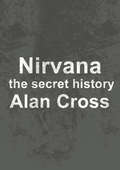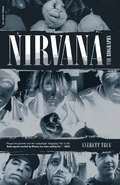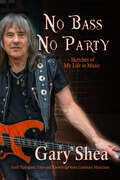- Table View
- List View
The Nightingale's Sonata: The Musical Odyssey Of Lea Luboshutz
by Thomas WolfA moving and uplifting history set to music that reveals the rich life of one of the first internationally renowned female violinists Spanning generations, from the shores of the Black Sea to the glittering concert halls of New York, The Nightingale's Sonata is a richly woven tapestry centered around violin virtuoso Lea Luboshutz. Like many poor Jews, music offered an escape from the prejudices that dominated society in the last years of the Russian Empire. But Lea’s dramatic rise as an artist was further accentuated by her scandalous relationship with the revolutionary Onissim Goldovsky. As the world around them descends in to chaos, between revolution and war, we follow Lea and her family from Russia to Europe and eventually, America. We cross paths with Pablo Casals, Isadora Duncan, Emile Zola and even Leo Tolstoy. The little girl from Odessa will eventually end up as one of the founding faculty of the prestigious Curtis Institute of Music, but along the way she will lose her true love, her father, and watch a son die young. The Iron Curtain would rise, but through it all, she plays on. Woven throughout this luminous odyssey is the story is César Franck’s “Sonata for Violin and Piano," a work championed by Lea, one of the first-ever internationally recognized female violinists. It became a touchstone for her, for her multi-generational family of musicians, and for scores of her students who played this masterwork throughout the world.
Nightmare on Hannah Street (Disney's Hannah Montana #7)
by Laurie McelroyPart 1: Miley Stewart loves being teen pop-star sensation Hannah Montana--but when her scheming, look-alike cousin Luann pays a visit, suddenly Miley isn't the only one who wants a taste of fame. At first Luann is on her best behavior, and might have gotten over the rough patch from their childhood. She even invites Luann to the coolest Halloween party in town. But when Luann hog-ties Miley in her secret Hannah Montana closet, Miley realizes she's made a big mistake! Can Miley's friends rescue her in time? Or will Luann crash the party of the year--dressed as Hannah Montana--and reveal her secret identity? Part 2: Mr. Stewart's mother comes to visit; Hannah has a command performance for the Queen, and Jackson has a volleyball tournament.
The Nikolais/Louis Dance Technique: A Philosophy and Method of Modern Dance
by Murray Louis Alwin NikolaisFirst Published in 2005. Routledge is an imprint of Taylor & Francis, an informa company.
Nikolay Andreevich Rimsky-Korsakov: A Research and Information Guide (Routledge Music Bibliographies)
by Gerald SeamanNikolay Andreevich Rimsky-Korsakov: A Research and Information Guide, Second Edition is an annotated bibliography of all substantial, relevant published resources relating to the Russian composer. First published in 1988, this revised and expanded volume incorporates new information about the composer appearing over the last two decades, including literary publications, articles and reviews. Other sections provide a brief biographical sketch, selective discography, chronology and list of Rimsky-Korsakov’s works.
A NIME Reader: Fifteen Years of New Interfaces for Musical Expression (Current Research in Systematic Musicology #3)
by Michael J. Lyons Alexander Refsum JenseniusWhat is a musical instrument? What are the musical instruments of the future? This anthology presents thirty papers selected from the fifteen year long history of the International Conference on New Interfaces for Musical Expression (NIME). NIME is a leading music technology conference, and an important venue for researchers and artists to present and discuss their explorations of musical instruments and technologies. Each of the papers is followed by commentaries written by the original authors and by leading experts. The volume covers important developments in the field, including the earliest reports of instruments like the reacTable, Overtone Violin, Pebblebox, and Plank. There are also numerous papers presenting new development platforms and technologies, as well as critical reflections, theoretical analyses and artistic experiences. The anthology is intended for newcomers who want to get an overview of recent advances in music technology. The historical traces, meta-discussions and reflections will also be of interest for longtime NIME participants. The book thus serves both as a survey of influential past work and as a starting point for new and exciting future developments.
Nina: Jazz Legend and Civil-Rights Activist Nina Simone
by Alice Brière-HaquetWith evocative black-and-white illustrations and moving prose, readers are introduced to jazz-music legend and civil-rights activist Nina Simone. A stunning picture-book biography of the High Priestess of Soul and one of the greatest voices of the 20th century. Shared as a lullaby to her daughter, a soulful song recounts Simone's career, the trials she faced as an African American woman, and the stand she took during the Civil Rights Movement. This poignant picture book offers a melodic tale that is both a historic account of an iconic figure and an extraordinary look at how far we've come and how far we still need to go for social justice and equality. A timeless and timely message aptly appropriate for today's social and political climates.♦ "A good introduction to Simone&’s life, from her early love of music to her rise to the status of legend" —Kirkus Reviews, starred review♦ "Strikingly illustrated" —Booklist, starred review♦ "Hauntingly beautiful illustrations" —Foreword Reviews, starred review"Stirring and powerful. . . " —BookPage
Nina: A Story of Nina Simone
by Traci N. ToddA 2022 Coretta Scott King Book Award Honoree! This luminous, defining picture book biography illustrated by Caldecott Honoree Christian Robinson, tells the remarkable and inspiring story of acclaimed singer Nina Simone and her bold, defiant, and exultant legacy. Cover may vary.Born Eunice Kathleen Waymon in small town North Carolina, Nina Simone was a musical child. She sang before she talked and learned to play piano at a very young age. With the support of her family and community, she received music lessons that introduced her to classical composers like Bach who remained with her and influenced her music throughout her life. She loved the way his music began softly and then tumbled to thunder, like her mother's preaching, and in much the same way as her career. During her first performances under the name of Nina Simone her voice was rich and sweet but as the Civil Rights Movement gained steam, Nina's voice soon became a thunderous roar as she raised her voice in powerful protest in the fight against racial inequality and discrimination.
Nina A Story of Nina Simone: A Story Of Nina Simone
by Traci N. ToddBorn Eunice Kathleen Waymon in small town North Carolina, Nina Simone was a musical child. She sang before she talked and learned to play piano at a very young age. With the support of her family and community, she received music lessons that introduced her to classical composers like Bach who remained with her and influenced her music throughout her life. She loved the way his music began softly and then tumbled to thunder, like her mother's preaching, and in much the same way as her career. During her first performances under the name of Nina Simone her voice was rich and sweet but as the Civil Rights Movement gained steam, Nina's voice soon became a thunderous roar as she raised her voice in powerful protest in the fight against racial inequality and discrimination.
Nine Choices: Johnny Cash and American Culture
by Jonathan SilvermanFor much of his career, Johnny Cash opened his shows with the tagline, "Hello, I'm Johnny Cash." This introduction seemed unnecessary, since everyone in the audience knew who he was--the famous musical artist whose career spanned almost five decades, whose troubled life on and off the stage received wide publicity, and whose cragged face seemed to express a depth and intensity not found in any other artist, living or dead. For Cash, as for many celebrities, renown was the product of both hard work and luck. Often a visionary and always a tireless performer, he was subject to a whirlwind of social, economic, and cultural countercurrents. Nine Choices explores the tension between Cash's desire for mainstream success, his personal struggles with alcohol and drugs, and an ever-changing cultural landscape that often circumscribed his options. Drawing on interviews, archival research, and textual analysis, Jonathan Silverman focuses on Cash's personal and artistic choices as a way of understanding his life, his impact on American culture, and the ways in which that culture in turn shaped him. Cash made decisions about where he would live, what he would play, who would produce his albums, whether he would support the Vietnam War, and even if he would flip his famous "bird"--the iconic image of Cash giving the finger which is now plastered on posters and T-shirts everywhere--in the context of cultural forces both visible and opaque. He made other decisions in consultation with a variety of people, many of whom were chiefly concerned with the reaction of his audiences. Less a conventional biography than a study of the making of an identity, Nine Choices explores how Johnny Cash sought to define who he was, how he was perceived, and what he signified through a series of self-conscious actions. The result, Silverman shows, was a life that was often tumultuous but never uninteresting.
Nine Inch Nails: The Secret History (The\secret History Of Rock Ser.)
by Alan CrossAlan Cross is the preeminent chronicler of popular music.Here he provides a history of Trent Reznor and Nine Inch Nails.This look at NIN—"Anger is an (Industrial) Energy"—is adapted from the audiobook of the same name.
Nine Inch Nails
by Martin HuxleySound, throb, and a long low wail of pure, hard pain... Nine Inch Nails. The world's most disturbing rock band is in effect one man singer and songwriter Trent Reznor. Since stealing the show during the original Lollapalooza tour in 1991, NIN has limned the hard edge of the techno revolution. In Reznor's desperate, combative persona and disarrayed melodies the musical community has finally found a band that appalls, confounds, and undeniably attracts. Horrified yet entranced, NIN's fans are like moths drawn toward the disfiguring flame of their music. From a well of previously unpublished research, Huxley has carved out the history of this improbable hero: Reznor's rise as an Appalachian outcast to dyspeptic sex symbol; his connections to Courtney Love; and his relationship with his spasmodically fixated fans. Ricocheting wildly between goth rock and industrial grunge, Nine Inch Nails has achieved a legendary sound. Here, Martin Huxley digs hard and deep to unearth the truth beneath the ultimate noise.
Nineteenth-Century British Music Studies: Volume 3 (Routledge Revivals Ser.)
by Peter HortonSelected from papers given at the third biennial conference on Music in Nineteenth-Century Britain, this volume, in common with its two predecessors, reflects the interdisciplinary character of the topic. The introductory essay by Julian Rushton foregrounds some of the questions that are key to this area of study: what is the nineteenth century? what is British music? and did London influence the continent? The essays which follow are divided into broad thematic groups covering aspects of gender, church music, national identity, and local and national institutions. This collection illustrates that while nineteenth-century British music studies is still in its infancy as a field of research, it is one that is burgeoning and contributing to our understanding of British social and cultural life of the period.
Nineteenth-Century British Music Studies: Volume 3 (Routledge Revivals)
by Peter Horton Bennett ZonOriginally published in 2003 and selected from papers given at the third biennial conference on Music in Nineteenth-Century Britain, this volume, in common with its two predecessors, reflects the interdisciplinary character of the topic. The introductory essay by Julian Rushton considers some of the questions that are key to this area of study: what is the nineteenth century, what is British music, and did London influence the continent? The essays that follow are divided into broad thematic groups covering aspects of gender, church music, national identity, and local and national institutions. This collection illustrates that while nineteenth-century British music studies is still in its infancy as a field of research, it is one that is burgeoning and contributing to our understanding of British social and cultural life of the period.
Nineteenth-Century British Music Studies: Volume 1 (Routledge Revivals)
by Bennett ZonOriginally published in 1999, this volume of essays arises from the first biennial Music in Nineteenth-Century Britain conference, held at the University of hull in July 1997. Like the conference, this book seeks to expand and reassess our current knowledge of musical life in Britain during the nineteenth century, as well as to challenge the preconceptions of earlier attitudes and scholarship. This volume covers a cohesive range of subjects and materials intended not only as a revision of past views and scholarship, but also as a tool for further research. It provides a vigorous reconsideration of the musical activity of the period.
Nineteenth-Century Chamber Music
by Stephen HeflingNineteenth Century Chamber Music proceeds chronologically by composer, beginning with the majestic works of Beethoven, and continuing through Schubert, Spohr and Weber, Mendelssohn, Schumann, Brahms, the French composers, Smetana and Dvorák, and the end-of-the-century pre-modernists. Each chapter is written by a noted authority in the field. The book serves as a general introduction to Romantic chamber music, and would be ideal for a seminar course on the subject or as an adjunct text for Introduction to Romantic Music courses. Plus, musicologists and students of 19th century music will find this to be an invaluable resource.
Nineteenth-Century Choral Music
by Donna M. Di GraziaNineteenth-Century Choral Music is an in-depth examination of the rich repertoire of choral music and the cultural phenomenon of choral music making throughout the period. The book is divided into three main sections. The first details the attraction to choral singing and the ways it was linked to different parts of society, and to the role of choral voices in the two principal large-scale genres of the period: the symphony and opera. A second section highlights ten choral-orchestral masterworks that are a central part of the repertoire. The final section presents overview and focus chapters covering composers, repertoire (both small and larger works), and performance life in an historical context from over a dozen regions of the world: Britain and Ireland, the Czech Republic, France, Germany, Hungary, Italy, Latin America, the Philippines, Poland, Russia, Scandinavia and Finland, Spain, and the United States. This diverse collection of essays brings together the work of 25 authors, many of whom have devoted much of their scholarly lives to the composers and music discussed, giving the reader a lively and unique perspective on this significant part of nineteenth-century musical life.
Nineteenth-Century Music: Selected Proceedings of the Tenth International Conference (Music In Nineteenth-century Britain Ser.)
by Jim Samson Bennett ZonThis selection of essays represents a wide cross-section of the papers given at the Tenth International Conference on Nineteenth-Century Music held at the University of Bristol in 1998. Sections include thematic groupings of work on musical meaning, Wagner, Liszt, musical culture in France, music and nation, and women and music.
Nineteenth-Century Opera and the Scientific Imagination
by David Trippett Benjamin WaltonScientific thinking has long been linked to music theory and instrument making, yet the profound and often surprising intersections between the sciences and opera during the long nineteenth century are here explored for the first time. These touch on a wide variety of topics, including vocal physiology, theories of listening and sensory communication, technologies of theatrical machinery and discourses of biological degeneration. Taken together, the chapters reveal an intertwined cultural history that extends from backstage hydraulics to drawing-room hypnotism, and from laryngoscopy to theatrical aeronautics. Situated at the intersection of opera studies and the history of science, the book therefore offers a novel and illuminating set of case studies, of a kind that will appeal to historians of both science and opera, and of European culture more generally from the French Revolution to the end of the Victorian period.
Nineteenth-Century Piano Music
by R. Larry ToddFirst Published in 2004. Routledge is an imprint of Taylor & Francis, an informa company.
The Nineties: What the F**ck Was That All About?
by John RobbIF YOU REMEMBER THE NINETIES...YOU WERE THERE!The Rock 'N' Roll Fifties. The Swinging Sixties. The trashy Seventies. The money-grabbing Eighties. There is a neat bunch of clichés for every era, but THE NINETIES...What the f**k was that all about?John Robb takes us on a personal odyssey through the definitive pop cultural moments that shaped the decade in the UK.
The Ninth: Beethoven and the World in 1824
by Harvey Sachs"All men become brothers . . . Be embraced, ye millions!" The Ninth Symphony, a symbol of freedom and joy, was Beethoven's mightiest attempt to help humanity find its way from darkness to light, from chaos to peace. Yet the work was born in a repressive era, with terrified Bourbons, Hapsburgs, and Romanovs using every means at their disposal to squelch populist rumblings in the wake of the French Revolution and Napoleon's wars. Ironically, the premiere of this hymn to universal brotherhood took place in Vienna, the capital of a nation that Metternich was turning into the first modern police state.The Ninth's unveiling, on May 7, 1824, was the most significant artistic event of the year, and the work remains one of the most precedent-shattering and influential compositions in the history of music--a reference point and inspiration that resonates even today. But in The Ninth, eminent music historian Harvey Sachs demonstrates that Beethoven was not alone in his discontent with the state of the world. Lord Byron died in 1824 during an attempt to free Greece from the domination of the Ottoman empire; Delacroix painted a masterpiece in support of that same cause; Pushkin, suffering at the hands of an autocratic czar, began to draft his anti-authoritarian play Boris Godunov; and Stendhal and Heine wrote works that mocked conventional ways of thinking.The Ninth Symphony was so unorthodox that it amazed and confused listeners at its premiere--described by Sachs in vibrant detail--yet it became a standard for subsequent generations of creative artists, and its composer came to embody the Romantic cult of genius. In this unconventional, provocative new book, Beethoven's masterwork becomes a prism through which we may view the politics, aesthetics, and overall climate of the era.Part biography, part history, part memoir, The Ninth brilliantly explores the intricacies of Beethoven's last symphony--how it brought forth the power of the individual while celebrating the collective spirit of humanity. From the Hardcover edition.
Nirvana: The Amplifications
by Michael AzerradMichael Azerrad reflects on the meaning of the revolutionary band, Nirvana, his friendship with Kurt Cobain, and the impact of the '90s thirty years later. Includes 20 images of posters and ephemera from the time. Note: This is the compilation of the essay-like annotations from THE AMPLIFIED COME AS YOU ARE: The Story of Nirvana, excluding the underlying 1993 book.
Nirvana: The Secret History (The\secret History Of Rock Ser.)
by Alan CrossAlan Cross is the preeminent chronicler of popular music.Here he provides a short history of Kurt Cobain and Nirvana.This look at "the vital link in '90s rock" is adapted from the audiobook of the same name.
Nirvana: The Biography
by Everett TrueAs the assistant editor of Melody Maker, Everett True was the first journalist to cover the Seattle music scene in early 1989 and interview Nirvana. <P><P> He is responsible for bringing Hole, Pavement, Soundgarden, and a host of other bands to international attention. He introduced Kurt Cobain to Courtney Love, performed on stage with Nirvana on numerous occasions, and famously pushed Kurt onto the stage of the Reading Festival in 1992 in a wheelchair. Nirvana: The Biography is an honest, moving, incisive, and heartfelt re-evaluation of a band that has been misrepresented time and time again since its tragic demise in April 1994 following Kurt Cobain's suicide. True captures what the band was really like. He also discusses the music scene of the time-the fellow bands, the scenes, the seminars, the countless live dates, the friends and allies and drug dealers. Drawn from hundreds of original interviews, Nirvana: The Biography is the final word on Nirvana, Cobain, and Seattle grunge.
No Bass No Party: Sketches of my Life in Music
by null Gary ShaeIt was Christmas time, December 27th, 1950. The Feast Of Saint John. General Douglas MacArthur had just landed in Korea. Nat King Cole had the number one hit song with MonaLisa. A howling snowstorm was making its way through the Naugatuck Valley in Connecticut. A Waterbury Police patrol car had just received a radio call to proceed to St. Mary's hospital a.s.a.p. The call was special to patrolman Joseph J. Shea as his wife had just given birth to their first child. Suddenly, cut off by another car in the storm, he found his patrol car barreling down a steep hill toward the raging Naugatuck River. He eventually regained control, inches from going over the guard rail and plunging into the nighttime freezing water.
